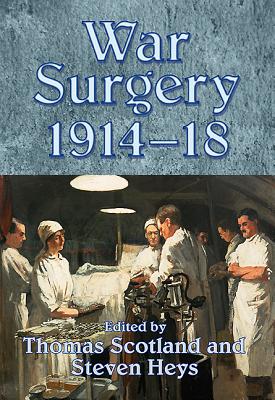War Surgery 1914-18

War Surgery 1914-18
The Great War, 1914-1918 resulted in enormous numbers of casualties who had sustained filthy contaminated wounds from high explosive shellfire, bomb and mortar blast, and from rifle and machine gun bullet. Such wounds were frequently multiple, severe, and almost invariably became infected. Surgical experience from previous conflicts was of little value, and it became quickly apparent that early surgical intervention with radical removal of all dead and devitalized tissue was absolutely vital to help reduce the chances of infections, especially the lethal gas gangrene, from developing. "War Surgery 1914-1918" explains how medical services responded to deal with the casualties. It discusses the evacuation pathway, and explains how facilities, particularly casualty clearing stations, evolved to cope with major, multiple wounds to help reduce their mortality. There are chapters dealing with the advances made in anesthesia, resuscitation and blood transfusion, the pathology and microbiology of wounding, and diagnostic radiology. There are also chapters dealing with the development of orthopedic surgery, both on the Western Front and in the United Kingdom, the treatment of abdominal wounds, chest wounds, wounds of the skull and brain, and the development of plastic and reconstructive surgery for those with terribly mutilating facial wounds. Major advances took place in the surgical management of casualties with all types of wound. Initially, abdominal wounds were treated by "expectant treatment". Observations by brilliant clinicians working in a logical and methodical way resulted in early surgical intervention with significant improvements in survival. Management of chest wounds became more aggressive as confidence and experience grew. Major exposure of combined chest and abdominal wounds through an incision opening both the chest and the abdomen became standard practice and these experiences laid the foundations for how these wounds are managed today. Similarly, application of basic surgical principles to the vast numbers of soldiers with head injuries saw an active policy for management of wounds of the skull and brain develop, with a concomitant improvement in survival, while huge numbers of facial wounds resulted in the development of plastic and reconstructive surgery, with complex methods of facial reconstruction being successfully developed. There is no doubt, however, that the evolution of orthopedic surgery was one of the most important development
PRP: 215.64 Lei
Acesta este Prețul Recomandat de Producător. Prețul de vânzare al produsului este afișat mai jos.
172.51Lei
172.51Lei
215.64 LeiLivrare in 2-4 saptamani
Descrierea produsului
The Great War, 1914-1918 resulted in enormous numbers of casualties who had sustained filthy contaminated wounds from high explosive shellfire, bomb and mortar blast, and from rifle and machine gun bullet. Such wounds were frequently multiple, severe, and almost invariably became infected. Surgical experience from previous conflicts was of little value, and it became quickly apparent that early surgical intervention with radical removal of all dead and devitalized tissue was absolutely vital to help reduce the chances of infections, especially the lethal gas gangrene, from developing. "War Surgery 1914-1918" explains how medical services responded to deal with the casualties. It discusses the evacuation pathway, and explains how facilities, particularly casualty clearing stations, evolved to cope with major, multiple wounds to help reduce their mortality. There are chapters dealing with the advances made in anesthesia, resuscitation and blood transfusion, the pathology and microbiology of wounding, and diagnostic radiology. There are also chapters dealing with the development of orthopedic surgery, both on the Western Front and in the United Kingdom, the treatment of abdominal wounds, chest wounds, wounds of the skull and brain, and the development of plastic and reconstructive surgery for those with terribly mutilating facial wounds. Major advances took place in the surgical management of casualties with all types of wound. Initially, abdominal wounds were treated by "expectant treatment". Observations by brilliant clinicians working in a logical and methodical way resulted in early surgical intervention with significant improvements in survival. Management of chest wounds became more aggressive as confidence and experience grew. Major exposure of combined chest and abdominal wounds through an incision opening both the chest and the abdomen became standard practice and these experiences laid the foundations for how these wounds are managed today. Similarly, application of basic surgical principles to the vast numbers of soldiers with head injuries saw an active policy for management of wounds of the skull and brain develop, with a concomitant improvement in survival, while huge numbers of facial wounds resulted in the development of plastic and reconstructive surgery, with complex methods of facial reconstruction being successfully developed. There is no doubt, however, that the evolution of orthopedic surgery was one of the most important development
Detaliile produsului









